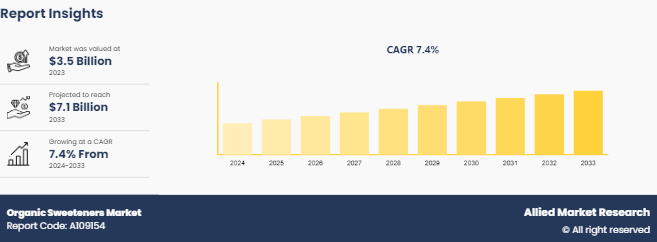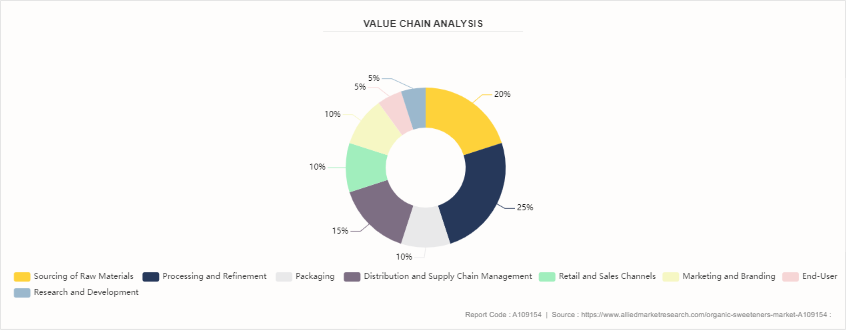Organic Sweeteners Market Research, 2033
Market Introduction and Definition
The global organic sweeteners market was valued at $3.5 billion in 2023, and is projected to reach $7.1 billion by 2033, growing at a CAGR of 7.4% from 2024 to 2033. Organic sweeteners are natural sweetening agents derived from organic sources, free from synthetic additives and chemicals. They are used as alternatives to conventional sugar in various food and beverage applications. These sweeteners include organic versions of sugar, honey, maple syrup, stevia, and agave nectar, which are produced through environment-friendly and sustainable methods. Organic sweeteners are popular among health-conscious consumers due to their perceived health benefits and reduced environmental impact compared to traditional sweeteners.

Key Takeaways
The Organic Sweeteners Industry study covers 20 countries, including a segment analysis for each country in terms of value ($Million) for the projected period 2024-2035.
Over 1, 500 product literatures, industry releases, annual reports, and documents from key industry participants, along with industry journals, trade associations, and government websites, have been reviewed for comprehensive industry insights.
The research integrates high-quality data, professional opinions, and critical perspectives to provide a balanced view of global markets and assist stakeholders in making informed decisions.
Key Market Dynamics
The organic sweeteners market is significantly influenced by the growing consumer preference for natural and healthier alternatives to refined sugars. This trend is driven by increasing awareness of the health risks associated with high sugar consumption, such as obesity, diabetes, and cardiovascular diseases. The demand for organic sweeteners continues to rise as more consumers opt for organic products due to their perceived benefits and environmental sustainability. In addition, the expansion of organic food categories and the integration of organic sweeteners into various products are contributing toward the market growth, increasing the Organic Sweeteners Market Size.
Economic factors, such as rise in disposable incomes and changes in lifestyle preferences, also play a crucial role in driving demand for organic sweeteners. The market for organic sweeteners is experiencing substantial growth as consumers prefer investing in premium, health-oriented products. However, higher production costs and price volatility of raw materials, which can affect the affordability and availability of organic sweeteners and Sugar Alternates limit the market growth. Despite these challenges, ongoing innovations, increased availability, and favorable regulatory support are expected to drive continued growth in the market, increasing the Organic Sweeteners Market Share.
Value Chain of organic sweeteners market
The value chain of the organic sweeteners market begins with the sourcing of raw materials, such as sugar cane, stevia, agave, coconut palm, and monk fruit, from farms that follow strict organic farming practices, avoiding synthetic chemicals and ensuring sustainability. After harvest, the raw materials are processed and refined using organic methods to extract the sweeteners, maintaining quality and adhering to organic certifications. Packaging plays a critical role, with products being packed in eco-friendly materials and offered in various formats like bulk containers or consumer-sized packages. The sweeteners are then distributed through a well-managed supply chain, including warehousing and transportation, ensuring efficient delivery to wholesalers, retailers, and e-commerce platforms. Companies promote their products through both traditional and digital marketing channels, emphasizing the organic, non-GMO, and health benefits of their offerings. Products reach consumers via supermarkets, health food stores, and online platforms, where feedback helps drive product innovation and development.

Market Segmentation
The organic sweeteners market is segmented into product type, source, application, and region. Based on product type, the market is fragmented into organic sugar, organic honey, organic maple syrup, organic stevia, and organic agave nectar. Based on source, the market is categorized into plant-based and non-plant-based. Based on application, the market is divided into food and beverages, pharmaceuticals, and personal care products. Region-wise, it is studied across North America, Europe, Asia-Pacific and LAMEA.
Regional/Country Market Outlook
North America is experiencing robust growth in the organic sweeteners market due to high consumer awareness of health and wellness trends, as well as a strong preference for organic and natural products. According to Organic Sweeteners Market Forecast, the U.S. and Canada lead the market, supported by a well-established retail infrastructure and a growing number of organic food retailers. The increasing adoption of organic sweeteners in both household and commercial applications is driving market expansion in the region.
Europe shows a growing demand for organic sweeteners, driven by stringent regulations on food safety and organic labeling. The European market benefits from a strong focus on sustainability and environmental conservation, which aligns with the increasing consumer preference for organic and natural products. Countries like Germany, France, and the UK are prominent players in the market, with a rising number of organic food products incorporating organic sweeteners.
Industry Trends
Increase in health consciousness and awareness of the negative effects of refined sugars are driving the demand for organic sweeteners. Consumers are seeking natural and less processed alternatives that offer better nutritional profiles and fewer adverse health effects. Moreover, the rise of clean-label and organic food trends is influencing the market, with consumers prioritizing products that are free from artificial additives and genetically modified organisms (GMOs) . This shift is leading to a greater preference for organic sweeteners in both processed foods and homemade recipes, increasing the Organic Sweeteners Market Growth.
Innovations in organic sweetener products, such as the introduction of new flavors and blends, are expanding the market. Companies are developing products that cater to specific dietary needs and preferences, such as keto-friendly or low-calorie options, to appeal to a broader consumer base. In addition, governments and regulatory bodies are promoting organic agriculture and sustainable practices, which support the growth of the organic sweeteners market. Various incentives and certifications for organic production are encouraging more producers to enter the market.
Competitive Landscape
Key players in the organic sweeteners market include Tate & Lyle PLC, Cargill, Inc., Pure Circle Ltd., Stevia First Corporation, Ingredion Incorporated, PureCircle Ltd., Whole Earth Sweetener Co., Merisant Company, NOW Foods, Wholesome Sweeteners, Inc. and ADM (Archer Daniels Midland Company) .
Recent Key Strategies and Developments
In 2023, Cargill launched a new line of organic stevia sweeteners aimed at enhancing flavor profiles in various food and beverage applications.
In 2022, Tate & Lyle introduced a range of organic syrups and sweeteners to meet the growing consumer demand for clean-label products.
Key Benefits For Stakeholders
- This report provides a quantitative analysis of the market segments, current trends, estimations, and dynamics of the organic sweeteners market analysis from 2024 to 2033 to identify the prevailing organic sweeteners market opportunities.
- The market research is offered along with information related to key drivers, restraints, and opportunities.
- Porter's five forces analysis highlights the potency of buyers and suppliers to enable stakeholders make profit-oriented business decisions and strengthen their supplier-buyer network.
- In-depth analysis of the organic sweeteners market segmentation assists to determine the prevailing market opportunities.
- Major countries in each region are mapped according to their revenue contribution to the global market.
- Market player positioning facilitates benchmarking and provides a clear understanding of the present position of the market players.
- The report includes the analysis of the regional as well as global organic sweeteners market trends, key players, market segments, application areas, and market growth strategies.
Organic Sweeteners Market Report Highlights
| Aspects | Details |
| Market Size By 2033 | USD 7.1 Billion |
| Growth Rate | CAGR of 7.4% |
| Forecast period | 2024 - 2033 |
| Report Pages | 245 |
| By Product Type |
|
| By Source |
|
| By Application |
|
| By Region |
|
| Key Market Players | Ingredion Incorporated, Tate & Lyle PLC,, Whole Earth Sweetener Co., Archer Daniels Midland Company, Cargill, Inc., PureCircle Ltd, Wholesome Sweeteners, Inc., Stevia First Corporation, NOW Foods, Merisant Company, Pure Circle Ltd. |
The global organic sweeteners market was valued at $3.5 billion in 2023, and is projected to reach $7.1 billion by 2033, growing at a CAGR of 7.4% from 2024 to 2033.
Key players in the organic sweeteners market include Tate & Lyle PLC, Cargill, Inc., Pure Circle Ltd., Stevia First Corporation, Ingredion Incorporated, PureCircle Ltd.,Whole Earth Sweetener Co. ,Merisant Company, NOW Foods ,Wholesome Sweeteners, Inc. and ADM (Archer Daniels Midland Company).
The global organic sweeteners market is evolving rapidly, driven by shifts in consumer preferences, health trends, and innovations in production.
The leading application of the organic sweeteners market is in the food and beverage industry.
The largest regional market for organic sweeteners is North America.
Loading Table Of Content...


